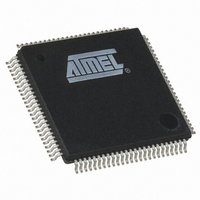AT91SAM7XC128B-AU-999 Atmel, AT91SAM7XC128B-AU-999 Datasheet - Page 23

AT91SAM7XC128B-AU-999
Manufacturer Part Number
AT91SAM7XC128B-AU-999
Description
IC MCU ARM7 128KB FLASH 100LQFP
Manufacturer
Atmel
Series
AT91SAMr
Datasheet
1.AT91SAM7XC128B-CU.pdf
(47 pages)
Specifications of AT91SAM7XC128B-AU-999
Core Processor
ARM7
Core Size
16/32-Bit
Speed
55MHz
Connectivity
CAN, Ethernet, I²C, SPI, SSC, UART/USART, USB
Peripherals
Brown-out Detect/Reset, DMA, POR, PWM, WDT
Number Of I /o
62
Program Memory Size
128KB (128K x 8)
Program Memory Type
FLASH
Ram Size
32K x 8
Voltage - Supply (vcc/vdd)
1.65 V ~ 1.95 V
Data Converters
A/D 8x10b
Oscillator Type
Internal
Operating Temperature
-40°C ~ 85°C
Package / Case
100-LQFP
Lead Free Status / RoHS Status
Lead free / RoHS Compliant
Eeprom Size
-
Available stocks
Company
Part Number
Manufacturer
Quantity
Price
8.5.5
8.5.6
8.6
8.7
6209DS–ATARM–17-Feb-09
Fast Flash Programming Interface
SAM-BA Boot Assistant
Non-volatile Brownout Detector Control
Calibration Bits
Flash Programming Interface, is forbidden. This ensures the confidentiality of the code pro-
grammed in the Flash.
This security bit can only be enabled, through the Command “Set Security Bit” of the EFC User
Interface. Disabling the security bit can only be achieved by asserting the ERASE pin at 1, and
after a full flash erase is performed. When the security bit is deactivated, all accesses to the
flash are permitted.
It is important to note that the assertion of the ERASE pin should always be longer than 220 ms.
As the ERASE pin integrates a permanent pull-down, it can be left unconnected during normal
operation. However, it is safer to connect it directly to GND for the final application.
Two general purpose NVM (GPNVM) bits are used for controlling the brownout detector (BOD),
so that even after a power loss, the brownout detector operations remain in their state.
These two GPNVM bits can be cleared or set respectively through the commands “Clear Gen-
eral-purpose NVM Bit” and “Set General-purpose NVM Bit” of the EFC User Interface.
Eight NVM bits are used to calibrate the brownout detector and the voltage regulator. These bits
are factory configured and cannot be changed by the user. The ERASE pin has no effect on the
calibration bits.
The Fast Flash Programming Interface allows programming the device through either a serial
JTAG interface or through a multiplexed fully-handshaked parallel port. It allows gang-program-
ming with market-standard industrial programmers.
The FFPI supports read, page program, page erase, full erase, lock, unlock and protect
commands.
The Fast Flash Programming Interface is enabled and the Fast Programming Mode is entered
when the TST pin and the PA0 and PA1 pins are all tied high.
The SAM-BA Boot Assistant is a default Boot Program that provides an easy way to program in-
situ the on-chip Flash memory.
The SAM-BA Boot Assistant supports serial communication via the DBGU or the USB Device
Port.
• GPNVM Bit 0 is used as a brownout detector enable bit. Setting the GPNVM Bit 0 enables
• The GPNVM Bit 1 is used as a brownout reset enable signal for the reset controller. Setting
• Communication via the DBGU supports a wide range of crystals from 3 to 20 MHz via
the BOD, clearing it disables the BOD. Asserting ERASE clears the GPNVM Bit 0 and thus
disables the brownout detector by default.
the GPNVM Bit 1 enables the brownout reset when a brownout is detected, Clearing the
GPNVM Bit 1 disables the brownout reset. Asserting ERASE disables the brownout reset by
default.
software auto-detection.
AT91SAM7XC512/256/128 Preliminary
23















